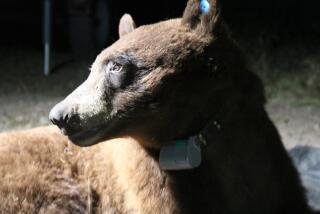No Need to Be Shaken by Rattlesnakes : Animal control officers find them in yards and in houses. About 200 people are bitten each year in the Southland, but it is rarely fatal.
In Southern California, they are as much a sign of summer as back-yard barbecues, just a lot less fun. Rattlesnakes, fanged creatures that repre sent nature at its most terrifying for most people.
The rattlesnake season, local experts explain, usually begins in April. As the days get warmer, the sightings increase. Thus, on an unseasonably steamy Sunday this spring, Los Angeles County Animal Control Officer Tim March answered six rattlesnake calls in and around the west San Fernando Valley.
In almost nine years on the job, March has heard that unmistakable rattle and seen that intimidating coil of poised reptile in some of the oddest places.
“I picked one up under a baby grand piano in Topanga,” he recalls. And then there was the rattler he found in a guy’s closet in Malibu. “It must have come up through the floorboards,” speculates March, who works out of the Los Angeles County Department of Animal Care and Control’s Agoura shelter.
Four dogs have been bitten so far this season (all survived), but no people, says March, whose territory extends from Woodland Hills to Westlake Village.
It’s no surprise that rattlesnakes are found throughout the greater Valley region. Chaparral is their natural habitat, and there is plenty of it locally.
According to Harvey Fischer, curator of herpetology at the Los Angeles Zoo, the odds of finding a rattlesnake in your back yard or driveway are directly related to where you live.
People who opt for a house that abuts the foothills can expect both inspiring natural vistas and the occasional snake.
“I live one block away from their natural habitat, and I’ve only seen two snakes in 15 years, neither of them rattlesnakes,” Fischer says. On the other hand, he says, “if you find one in your neighborhood, eventually you’ll find another one.”
According to Fischer, the only species of rattler that you’re likely to find in the Valley and adjacent areas is the Southern Pacific rattlesnake. The Mojave green, which carries a higher proportion of neurotoxin, rarely slithers any closer than the Palmdale area, where the sidewinder is also found.
Local rattlesnakes, which start out a mottled light brown and get darker as they get older, tend to be much smaller in real life than in our imaginations, rarely exceeding four feet in length. “A five-footer’s a giant one,” Fischer says.
While rattlesnakes are venomous, they are not nearly the threat that their reputation would suggest. “The chances of a person being killed by a rattlesnake in Southern California are much less than the chances of being killed by lightning,” Fischer says. Lightning kills an average of more than 90 Americans each year, while rattlesnakes kill perhaps a dozen people annually. (Fatalities are highest in areas of the South where poisonous snakes are routinely handled in religious ceremonies and treatment is not always sought.) Southern California averages a single fatality every other year, Fischer says, “pretty low considering there are many millions of people here who spend a lot of time outdoors.”
While rattlers rarely kill anyone, they bite about 200 Southern Californians every year. According to Willis E. Wingert, a physician retired from County-USC Medical Center and one of the nation’s few medical experts on rattlesnakes, most bite victims are young men. Bites occur on hands and arms in 85% of the cases. Other fun facts about bite victims from Wingert’s files: One in three is drunk and one in five is tattooed.
Fischer advises people who encounter a rattlesnake in the wild, or in the wilds of their own back yard, to stay away from it.
“Admire it, walk around it, give it a wide berth and let it crawl off on its own,” he says. He also points out that many times what non-experts assume is a rattler is really a harmless gopher snake or California king snake, two common, non-venomous species that, like the rattlesnake, keep the rodent population in check (California king snakes also eat young rattlesnakes).
It’s no wonder that amateurs are fooled, Fischer says. Both gopher and king snakes shake their tails during encounters with humans, although neither has a rattling device. “Gopher snakes especially will really act tough,” he notes. “They’ll flatten their head. When you’re smaller, you have to try harder.”
Although local snake sightings are few in winter (March doesn’t ever remember getting a rattlesnake call in December), they are possible any time of year. “Snakes don’t have full-blown hibernation in Southern California because of the weather,” Fischer says.
*
Conventional wisdom is that young snakes are more dangerous than full-grown ones, and there is some truth to that, the experts say.
“Young snakes are more apt to bite and tend to pump all their venom into you,” says Frank Bongiorno, animal control’s supervisor of field services in Agoura. Larger snakes deliver a larger percentage of “dry” or non-venomous bites.
Given that the snakes are out there, Fischer thinks that it’s prudent for hikers to always venture out with someone else. Carrying a commercial snake-bite kit is also a good idea, he says. If you are bitten, don’t do a Rambo and cut an X into the wound and try to suck the venom out (you’re liable to do more harm than good, injuring nerves and tendons, especially if you’re bitten on the hand).
*
“Stay calm,” Fischer urges. “If you get to a hospital in four hours, you’ve got no worries,” (assuming that the hospital has a supply of antivenin). “A snake bite isn’t synonymous with death.”
Children and small people (as well as small pets) are more at risk than larger ones. “The venom works not unlike medication,” Fischer points out, and a larger body can handle more.
Some people think that the only good rattlesnake is a dead one. Many fire departments and even some animal control officials destroy rattlesnakes they pick up. Officers with the Los Angeles Department of Animal Regulation carry firearms and shoot the occasional snake, although more often the animals are dispatched with a shovel borrowed from a frightened homeowner.
But March and his colleagues try to protect both the residents and snakes. They answer rattlesnake calls equipped with snake-handling tongs and a specially made wooden box for holding the unwelcome creatures until they can be released unharmed, usually somewhere in the Santa Monica Mountains. The policy at the Agoura shelter, March explains, is “duty with compassion.”
“We feel here that snakes have a niche in the environment,” he says. Why not let them live their lives out in the hills, doing their useful rodent control? After all, he says, with a grin, “they have their place in the circle of life.”
More to Read
Sign up for Essential California
The most important California stories and recommendations in your inbox every morning.
You may occasionally receive promotional content from the Los Angeles Times.










